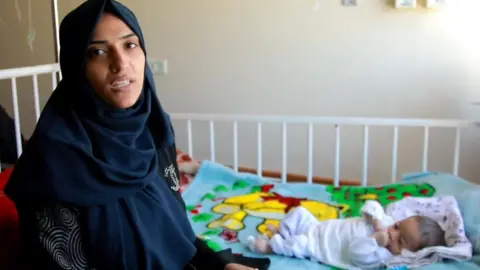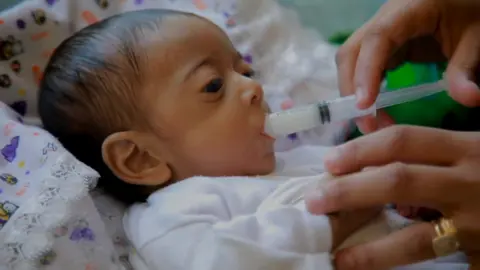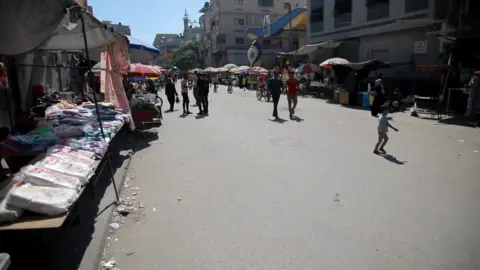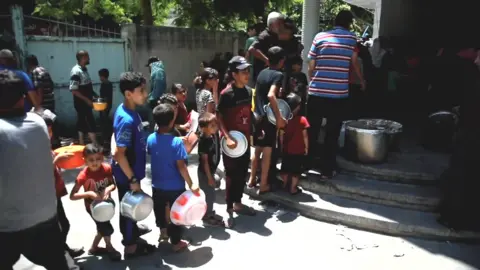By Adnan El-Bursh, BBC Arabic, Gaza correspondent
 BBC
BBCFive-month-old Abdulaziz al-Hourani lies in his bed at al-Ahli hospital in northern Gaza, his small body showing signs of undernourishment.
Weighing only 3kg (6.6lb), Abdulaziz has just been released from the intensive care unit, where he was treated for severe malnutrition.
His mother says she can’t get the food he needs in Gaza. “This is my only baby. He is supposed to weigh at least 5kg (11lb) and I am very worried about his health,” she says. “I can’t take him abroad because the borders are closed.”
Abdulaziz’s story is not unique. According to the World Health Organization (WHO), more than 8,000 children under the age of five have been diagnosed and treated for acute malnutrition since the war began – of those 1,600 were severe cases.
Last week, WHO director general Dr Tedros Adhanom Ghebreyesus said there had “already been 32 deaths attributed to malnutrition, including 28 among children under five”.
At the beginning of June, the UN’s children’s agency, Unicef, reported that nine out of 10 children in Gaza were experiencing severe food poverty, surviving on two or fewer food groups per day. It said that “months of hostilities and restrictions on humanitarian aid have collapsed the food and health systems, resulting in catastrophic consequences” and that children were “at risk of life-threatening malnutrition”.

Empty markets
I was born in Gaza and lived there with my family – I reported from there until February.
Before the war, I knew northern Gaza’s al-Tufah district as a bustling place with thousands of shoppers. But when I call people still there to ask about conditions, they send me pictures showing it is now nearly deserted.
“There are no tomatoes, no cucumbers, no fruit, and no bread,” says Salim Shabaka, an elderly man at the market. He tells me only some used clothes and a limited supply of canned foods are on display.
“We have never known life like this – nothing to buy or sell,” adds another street vendor.
“I have seven children and have not received any aid.”
Every day, long queues form in front of “Tikkeyas” – small food stalls providing free meals. Many have been funded by better-off individuals in northern Gaza, but the shortage of supplies means their future is uncertain.
For now, this is where some children go to try to get a hot meal, while others walk long distances to fetch water.

Hunger and disease
Almost every day, I speak to relatives and friends in Gaza. In the pictures they send me I can see they have lost weight and I notice the change in their faces.
And Dr Tedros at the WHO has warned that “despite reports of increased delivery of food, there is currently no evidence that those who need it most are receiving sufficient quantity and quality of food”.
He added that, due to insecurity and lack of access, only two stabilisation centres for severely malnourished patients could currently operate. He warned that the lack of health services, clean water and sanitation “significantly increases the risk of malnourished children”.
The situation means the spread of infectious diseases, such as hepatitis, is also more likely. Most hospitals and clinics are closed, and those still operating are damaged and overcrowded.
“We are drained and out of energy,” says Umm Fouad Jaber, an elderly woman from Jabalia, in northern Gaza. “We have been displaced several times, and people are being killed every day.”
“We have eaten animal food, and children and women pass out because of malnutrition. Diseases have eaten our bodies.”
Palestinian doctor Moatasem Saed Salah, a member of the emergency committee at the Hamas-run health ministry, confirms that dozens of cases of malnutrition are reported every day, especially among children and pregnant and breastfeeding women.
He says many people, already suffering from chronic diseases, are now struggling with other health conditions too.
Humanitarian aid challenges
The war began after Hamas attacked Israel on 7 October, killing about 1,200 people and taking 251 others back to Gaza as hostages.
The Hamas-run health ministry says more than 37,000 Palestinians have been killed since the start of the war, and many hundreds of thousands more have been injured or displaced.
Gazans have looked to humanitarian aid to survive, but not enough supplies are getting through.

At one point, the Rafah crossing on the Egyptian border in the south of Gaza was the main point of entry for aid. But with Israel now controlling the Gaza side of the crossing, it is closed.
Also in the south is the Kerem Shalom gateway from Israel. It is open, but fighting has restricted the flow of aid along this route.
Some food is also being shipped to the north through new crossing points, but the volume of aid has dropped by two-thirds since 7 May, according to UN figures, and supplies are dwindling in the south, according to the World Food Programme.
A US-built floating pier for aid shipments was out of operation for days after being damaged by bad weather, and has since been temporarily moved due to high seas.
Twenty international aid agencies warned that the “unpredictable trickle of aid into Gaza has created a mirage of improved access while the humanitarian response is on the verge of collapse”.
Last week, Gaza’s Hamas-run government reported that no more than 35 lorries were arriving in Gaza each day, and said these are the only source of food and medicine for 700,000 people in north Gaza.
But in a post on X on 13 June, the Israeli body responsible for humanitarian co-ordination, Cogat, said: “Over one billion pounds of food were transferred to Gaza since the start of the war.
“There is no limit to the [a]mount of humanitarian aid, including all kinds of medicines that can enter Gaza.”
In another post on the same day Cogat said 220 aid lorries had entered Gaza that day. It blames aid agencies for logistical failures in distributing food and other supplies, and says more than 1,300 aid lorries are still waiting to be collected.
The UN says distribution of what does get through is severely hampered by fighting, the breakdown of law and order, and other Israeli restrictions.
On Sunday, the Israeli military announced daily “tactical pauses of military activity” along a road in southern Gaza to allow more humanitarian aid to enter. But it emphasised that there was no ceasefire and that combat would continue in Rafah. Israel says its operation in Rafah is necessary to oust Hamas from what it calls the group’s “last major stronghold”.
These pauses, which were said to have begun on Saturday, will be from 08:00 to 19:00 local time (05:00 to 16:00 GMT) and will only affect a route leading northwards from the Kerem Shalom crossing.
A UN spokesperson welcomed the announcement but on Sunday noted it hadn’t yet increased aid on the ground.
UN agencies earlier warned that if hostilities continued, more than one million Palestinians in Gaza could face severe starvation by mid-July.


